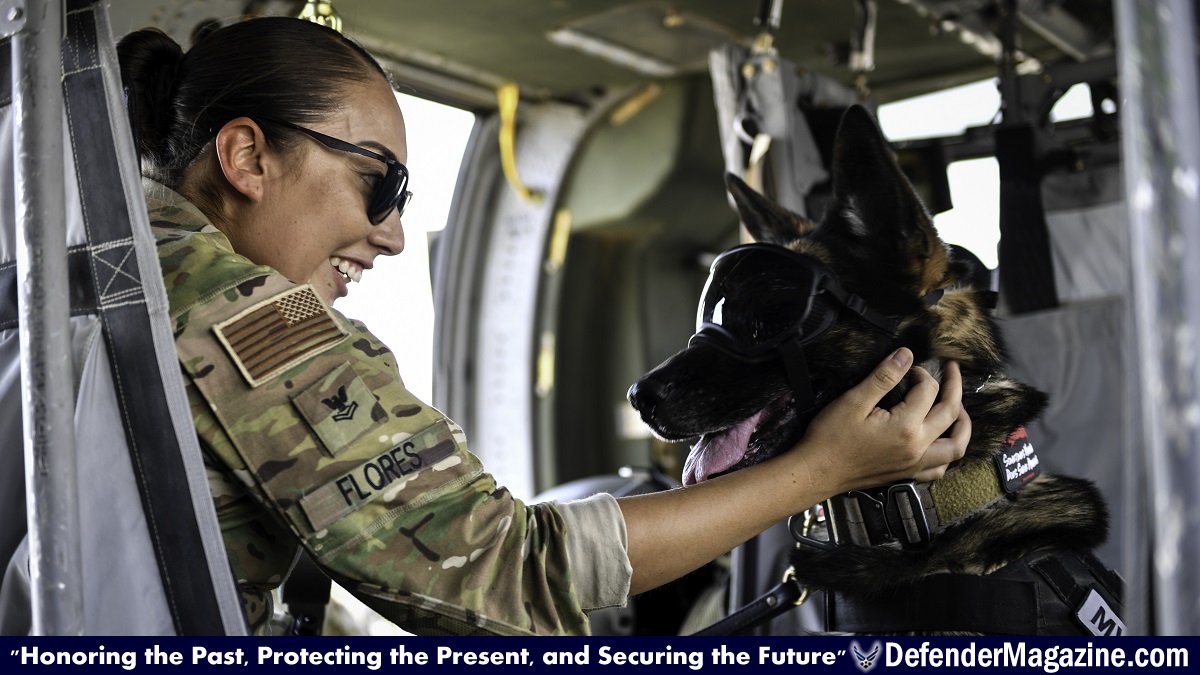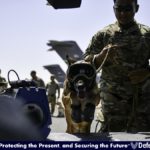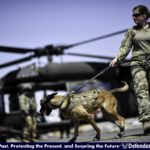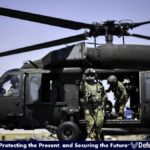A U.S. Army, Navy, and Air Force joint service MEDEVAC exercise included the 386th ESFS.
U.S. Navy Master-at-Arms 2nd Class Brianna Flores, Area Support Group Kuwait – Directorate of Emergency Services – K-9 Unit Military Working Dog handler, comforts her military working dog after boarding a UH-60 Black Hawk helicopter at Ali Al Salem Air Base, Kuwait, Sept. 13, 2019. As part of the exercise, U.S. Army veterinary doctors worked with emergency medical responders sharing life-saving measures for MWDs in case of extreme emergencies where veterinary technicians might not be immediately available. (U.S. Air Force photo by Staff Sgt. Mozer O. Da Cunha)
ALI AL SALEM AIR BASE, Kuwait (AFNS) —
Military Working Dog liaison officers with the 386th Expeditionary Security Forces Squadron, Airmen with the 386th Expeditionary Medical Group and Soldiers from the 5th Battalion, 159th General Support Aviation Battalion deployed to Camp Buehring, Kuwait, conducted medical evacuation and UH-60 Black Hawk acclimation training with more than 15 U.S. Army, Navy and Air Force MWD teams in the U.S. Central Command area of responsibility at Ali Al Salem Air Base, Sept. 13.
U.S. Army veterinarian clinical specialist worked together with emergency medical responders, sharing life-saving measures for MWDs in case of extreme emergencies where veterinary technicians might not be available.
“K-9 handlers themselves are taught basic first-aid measures to help their dogs and combat life-saving skills,” said Tech. Sgt. Miguel Rodriguez, 386th ESFS, MWD liaison. “They have that training to stabilize the dog and keep the dog alive for as long as they can until a veterinarian can arrive. In case a veterinarian is not available, medical personnel use their expertise to take those basic combat life-saving skills one step further to assist and keep the dog stabilized and alive as long as they can until they can get the patient to the proper location to give them the next level of care.”
While emergency responders are not necessarily trained in veterinary medicine, by receiving that extra training by professionals, they can modify the skills they possess to fill that role in an emergency.
“It actually was interesting to see that most of the skills we use as medical technicians will translate to a veterinarian technician,” said Staff Sgt. Nikole Loboi, 386th EMDG medical technician. “We learned about where we can place an IV, how to do CPR and the normal vital signs for a dog, which actually are not that different from working with humans. The main thing that we have to know is the different anatomy of whatever animal we are treating at the time.”
With the primary objective for the exercise complete, trainers moved on to the second phase of the training and worked on getting teams acclimated to boarding a UH-60 Black Hawk.
“Another of our main objectives for this exercise was habituation,” Rodriguez added. “That’s when you create an unfamiliar environment and you put the dog inside that environment. We slowly introduce them to those new experiences, we let them see that environment multiple times, eventually, they get used to the new environment.”
MWDs are critical assets in most military missions around the globe and while effective, they are living creatures. Therefore, they have different personalities, fears and reactions to unknown situations.
“When you put an MWD inside a new environment for the first time, you never know how they are going to react,” Rodriguez said. “Sometimes for the dog, being put in that environment for the first time is like being thrown in the deep end of a pool. People don’t want to learn that way and dogs don’t want to learn that way either. That’s not the best way to introduce a dog to a new type of environment.”
To slowly acclimate the dogs, the Black Hawk crew and trainers conducted a three-step approach with each team.
“What you want to do is take baby steps,” Rodriguez said. “The first thing that we did was a cold load where the dogs and the handlers boarded the helicopter with the engines off. That allowed the dogs to sniff around the helicopter and see that there is nothing to worry about. The second step was a hot load where we repeated step one but with the engines on that was used to introduce the dogs to the noise and wind created by the engines. Step three was boarding the helicopter and doing a familiarization flight around the installation.”
MWD handlers share their experiences in boarding and conducting training with their dogs.
“The first time MWD Jerry and I went up, he was jittery not being too familiar with what was going on, the moving parts and pieces of it all,” said Spc. Manuel Paulino, Area Support Group Kuwait – Directorate of Emergency Services – K-9 Unit MWD handler. “He took it especially hard when we took off from the ground. This second time around, he was much more comfortable with me and we got through the threshold that other dogs might hesitate to get through initially. He got in the helicopter and he was very comfortable not only with me but with the aircrew as well. That was an improvement from the first time we went through it. This time around, he was much more comfortable, he sat and enjoyed the ride.”
Participants not only got the training they needed, but they also got an opportunity to network with other MWD teams from other military branches in the area of responsibility.
“Having met the other handlers in the AOR was pretty good in the essence of being able to network and kind of familiarize myself with who is involved in our field in this area,” Paulino said. “Being able to see how other handlers operate based on where they are stationed in the AOR was very interesting. We also got to see how other branches function, learning the subtle differences in how we work was very educational.”
By Staff Sgt. Mozer O. Da Cunha, 386th Air Expeditionary Wing Public Affairs / Published September 23, 2019
U.S. Air Force Staff Sgt. Adrian Magaling, 386th Expeditionary Security Forces Squadron Military Working Dog handler, and MWD Lizzy, board a UH-60 Black Hawk helicopter as part of medical evacuation training at Ali Al Salem Air Base, Kuwait, Sept. 13, 2019. The walkthrough was phase one of the exercise where teams conducted a cold load by boarding the aircraft with the engines off for their dogs to acclimate to the new environment. (U.S. Air Force photo by Staff Sgt. Mozer O. Da Cunha)
U.S. Air Force Staff Sgt. Kathyrn Malone, 386th Expeditionary Security Forces Squadron Military Working Dog handler, and MWD UUrska, exit a UH-60 Black Hawk helicopter as part of medical evacuation training at Ali Al Salem Air Base, Kuwait, Sept. 13, 2019. The team participated in phase two of the exercise consisting of boarding the aircraft with the engines on. The objective was to get MWDs acclimated to the noise and wind created by the helicopter’s rotating blades. (U.S. Air Force photo by Staff Sgt. Mozer O. Da Cunha)
A UH-60 Black Hawk crewmember signals a Military Working Dog team to board the aircraft at Ali Al Salem Air Base, Kuwait, Sept. 13, 2019. As part of the exercise, U.S. Army veterinary doctors worked together with emergency medical responders sharing life-saving measures for MWDs in case of extreme emergencies where veterinary technicians might not be immediately available. (U.S. Air Force photo by Staff Sgt. Mozer O. Da Cunha)



